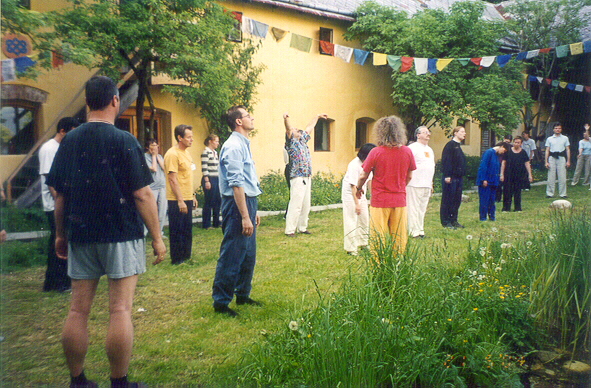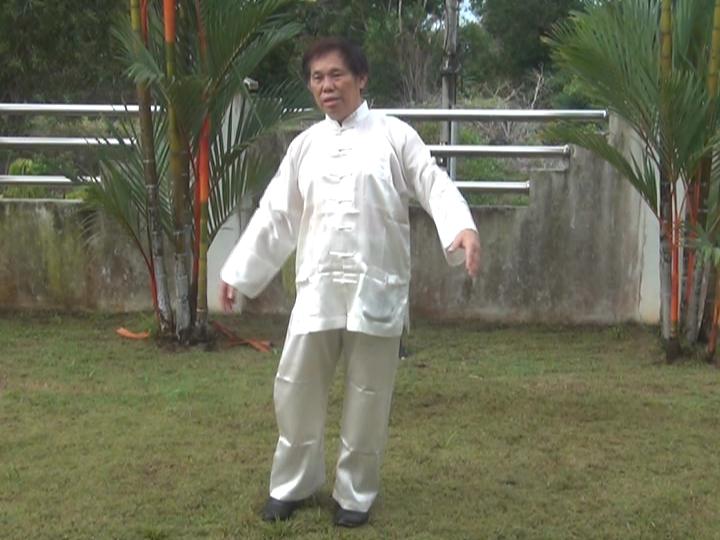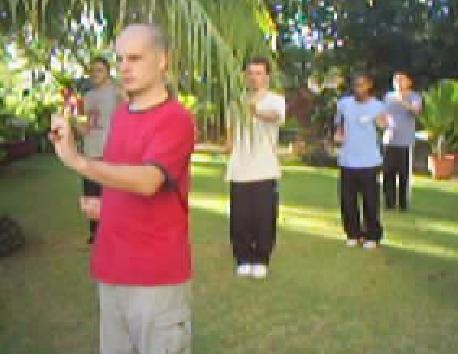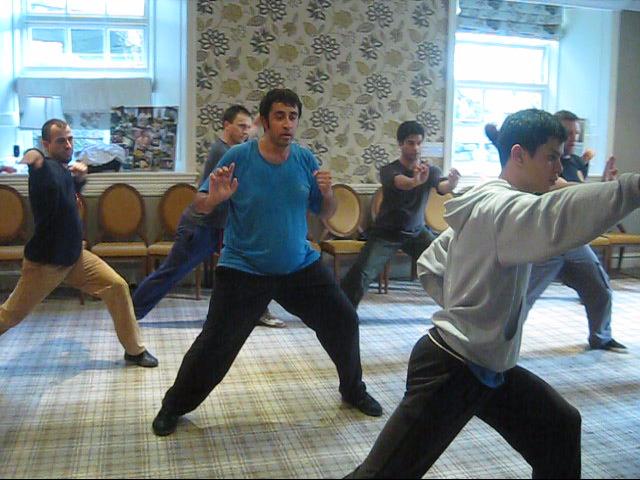SELECTION OF QUESTIONS AND ANSWERS
MAY 2013 PART 3

Chi flow, a hallmark of our school
Question 1
Sifu, chi flow is a hallmark of our school. Can you tell us who you learned chi flow from? Was it from Uncle Righteousness or Sigung Ho Fatt Nam?
— Sifu Mark Appleford, Chief Instructor, Shaolin Wahnam UK
Answer
Yes, you are right. Chi flow is the hallmark of our school. In fact, Tim (Sifu Tim Franklin of UK) mentioned that 500 years from now when people pointed to our school, the most prominent feature they noticed would be chi flow.
Chi flow has enabled us to help many people overcome so-called incurable diseases. For those who train internal force (which is practically everyone in our school), chi flow frees them from the concern of deviated training. Hence, we have the luxury of "Don't Worry" being the first golden rule of our practice.
This is a great advantage, and it contributes much to rapid progress. Some people in the West may be surprised to know that a lot of people in the East are concerned about deviated training. Indeed, this concern, or even fear, prevents many from seeking to learn internal arts. For those who venture bravely to learn an internal art, this concern or fear, usually insidiously, hinders their progress as it affects their mind-set which is very important in internal art training.
It speeds up our progress unbelievably. Even for me, when I took one or two years to experience internal force in a particular force-training exercise, our students now can experience internal force in the same exercise in a matter of days! It is just unbelievable but true.
I did not learn chi flow from Sifu Ho Fatt Nam or Uncle Righteousness. Uncle Righteousness did not talk about chi flow. Although there was some gentle chi flow in Sifu Ho Fatt Nam's school, he did not encourage vigorous chi flow.
Chi flow developed in the long process of my own training and teaching. I heard of and read about chi and its importance in internal force development. There is a kungfu saying as follows: "The essence of internal force is chi".
My first experience of chi flow was when practicing One-Finger Shooting Zen learnt from Sifu Ho Fatt Nam. But I did not know it was chi flow then, neither did my sifu tell me so. Like any good student in a traditional kungfu context, I just practiced what my sifu asked me to, without understanding its underlying philosophy.
Yet, I was different from other traditional good students. I read a lot of kungfu classics, and had frequent discussion with my sifu on kungfu philosophy. I read about a kind of chi kung developed by the great Chinese physician, Hua Tou, called Five-Animal Play where practitioners moved about in what we would now call self-manifested chi movement.
Years later when I set up Shaolin Wahanm Association and Shaolin Wahnam Chi Kung Clinic in Sungai Petani, I was quite well-known and respected. A kungfu and chi kung master from another city came to me for help, which I rendered him. (Later he betrayed me, and instigated some of my senior students against me.)
I learned that he taught Flying Crane Chi Kung which had self-manifested chi movement as its main approach. I was interested and he invited me to visit his classes. He students performed about 30 different exercises then went into vigorous chi flow.
He also volunteered to induce self-manifested chi movement in me. He tried to transmit chi to me via my ming meng vital point (located at the back along the waist), but my chi flow was so powerful that he was repelled away.
I tried to induce self-manifested chi movement myself. I opened my bai-hui vital point (at the crown of the head) and massage my qi-hai vital point (at the abdominal dan tian), like what this master taught his students and also what I read in chi kung classics. Then I performed the 30 odd Frying Crane Chi Kung exercises in a chi kung state of mind.
Before I could complete about half of the intended exercises, I was already in a vigorous chi flow. The chi flow was so powerful that I went round and round my living room quite uncontrollably. It was my first time experiencing a very vigorous self-manifested chi movement and I did not know how to stop.
I had an idea. I threw myself onto a sofa to stop the vigorous chi movement. I did stop going round and round, but it was a very unpleasant feeling. Now I know that if a practitioner has this problem when stopping suddenly, he just has to go into some gentle chi flow, then think of his dan tian to let his flowing chi settle down. But I did not know this technique then.
I researched the many chi kung classics that I had and learned a lot about self-manifested chi movement. I learned various techniques to induce a vigorous chi flow, like stimulating energy points, performing gentle movements faster and faster, and feeling like drifting peacefully in clouds.
When my students in my various Eighteen Lohan Hands classes (which lasted for 6 months at that time) started to experience some chi movement, I encouraged them to go on. But at that time, I was new to self-manifested chi movement, so I was very careful, following and monitoring each student at a time as he (or she) enjoyed his more than average chi flow, asking him to slow down when the movement became too vigorous. Now I know that self-manifested chi movement is very safe, and I can go for a drink, leaving students to run and jump like monkeys and kangaroos on their own, provided, of course, the practice place is safe.
I explained the philosophy of self-manifested chi movement, which I learned from chi kung classics, to my classes. I explained, for example, that chi from different internal organs manifested in characteristic ways, which are symbolized by the bird which relates to the heart, the deer which relates to the liver, the monkey which relates to the spleen, the tiger which relates to the lungs, and the bear which relates to the kidneys.
I noticed that students who recovered from serious illness, like asthma, diabetes, cancer, cardio-vascular disorders and kidney stones, usually had sessions of vigorous self-manifested chi movement prior to their recovery. Looking back with hindsight, this laid the seed of my conclusion now that it is chi flow, not the chi kung exercises themselves, that brings benefits of good health, vitality and longevity.
I reckoned that as self-manifested chi movement was so useful, I could devise appropriate exercises to induce it, instead of letting it develop gradually from Eighteen Lohan Hands. So I composed two sets of chi kung exercises specially to induce self-manifested chi movement.
The first set consisted of Push Mountain Lift Sky, Double Dragons and Fish Flip. This was meant to induce a vigorous forward-backward flow. The second set consisted of Dancing Fairy, Bear Walk and Swinging Hips. This was meant to induce a sideway or a circular flow.
These two sets of self-manifested chi movement exercises were very effective. By then I had reduced the Eighteen Lohan Hands course from six months to three months. These two sets of exercises could enable students to have a vigorous chi flow in a few days instead of a few months. Those of you who learned from me in my early years of world-wide travels, like in Spain, Portugal and Germany, would have learnt these self-manifested chi movement exercises.
Chi flow has helped us tremendously in internal force development. I remember the first time I taught Lifting Water to a student in Australia, Ken, who was a Tai Chi instructor. After lifting our hands about a dozen times, we felt tremendous force in our hands. On hindsight, it was due to chi flow.
Lately I was investigating why our students could develop internal force in a matter of days when masters in the past, including myself, took years. A main reason was that we differentiated between skills and techniques. And the principal skill was our ability to generate chi flow.
I had a historic confirmation when teaching Iron Wire in Barcelona last year (2011). First I taught them the force-method, which is the orthodox method for Iron Wire. Then I taught them the flow-method. I asked the students to compare the two methods and tell me from their direct experience which method was more powerful. I was actually quite surprised when all of them told me the flow-method.
Having found that the flow-method produces better result, when I taught Iron Wire in Killarney in 2011, I mainly used the flow-method though I also introduced the force-method in passing. What was most outstanding about the Ireland Iron Wire Course was mental clarity, besides tremendous internal force. I have no doubt that the flow-method contributed much to the attainment of mental clarity, but I have not found out the philosophical explanation yet.
I had another confirmation recently in Frankfurt (September 2012). After teaching the force-method the first two days to develop internal force in the Triple Stretch, which produced a lot of force, I taught the students the flow-method on the third day. I asked them to compare the two methods and tell me from their direct experience which method produced more force. This time I was not surprised that 10 of them told me the flow-method and 2 said they were not sure.
Question 2
How would you rate chi flow in our school? Would you consider it a unique feature of our teaching? I haven't seen chi flow taught in this way in any other schools.
Answer
Chi flow is extremely important in our school. It is because of chi flow that we can achieve such incredible results in such unbelievable short time.
People with so-called incurable diseases like asthma, cardio-vascular disorders, cancer, diabetes, depression and phobia overcome their illness after practicing chi kung learnt from us. This is because of chi flow.
When it takes months for normal students to experience internal force if they are lucky to be taught this privileged art, our students take only days. Even our students who attend my intensive courses can spar for hours without being tired or panting for breath, which is a skill of masters. This is because of chi flow.
Our students in advanced courses like Merging with the Cosmos and Small Universe experience spiritual awakening like their spirit expanding into the Cosmos and finding themselves nowhere and everywhere, an attainment even monks cultivating in monasteries take years to attain. This is because of chi flow.
Yes, chi flow is unique in our teaching. I too have not seen any other schools teach chi flow the way we do.
Some masters have chi flow, but they did not learn it systematically. They developed it without conscious knowing through many years of dedicated training. Hence they do not teach it systematically to their students.
Some schools, like those teaching self-manifested chi movement, have chi flow as part of their repertoire, but unlike us they do not incorporate it in their daily life.
On the other hand, many masters and schools think that vigorous chi flow is a deviation or at least harmful.
Yet, chi flow was found in the past and recorded in chi kung and kungfu classics. But not many people understood it because, I believe, it was kept as top secret.
Hua Toa's Five-Animal Play is a classical example. Flowing Breeze Swaying Willows is another famous but little understood example from Shaolin Kungfu. I believe Cloud Hands in Taijiquan developed from Flowing Water Floating Clouds, which poetically described Taijiquan movements in chi flow.

Flowing Water Swaying Willows
Question 3
Are there any interesting stories about your learning or teaching of chi flow?
Answer
My first encounter with the term chi flow was a Chinese kungfu story told by a famous Chinese story-teller called Li Tai Sor, broadcasted over Rediffusion, a local cable-network broadcasting service in Penang, Malaysia, when I was a small boy, of Foong Sai Yoke jumping up onto a lui-tai or high platform to fight with Looi the Tiger.
As Foong Sai Yoke landed on the high platform, he swayed gently in a famous Shaolin technique called Flowing Breeze Swaying Willows. It was only years later that I knew his was chi flow.
When I was learning Shaolin Kungfu from Sifu Ho Fatt Nam, I sometimes swayed after performing a kungfu set. It gave me a pleasant sensation and I felt charged with internal force. But my sifu discouraged me from going into vigorous chi flow.
Years later I had a rare opportunity to watch a video from China showing an old Shaolin master performing the famous Flower Set. Videos from China then were very rare, and anyone practicing traditional kungfu was rarer still. At the end of his performance, as he lowered his hands at his sides, he swayed gently like we do now. It then struck me that that was Flowing Breeze Swaying Willows.
When I learned One-Finger Shooting Zen from Sifu Ho Fatt Nam, it was performed on a Horse-Riding Stance. But Grandmaster Lam Sai Weng's classic, Tiger-Crane Double Form, showed him performing One-Finger Shooting Zen while standing upright. I tried performing One-Finger Shooting Zen standing upright, and soon found myself swaying vigorously in chi flow.
The chi flow also made me bend my knees involuntarily into the Two-Character Stance, as chi sank into my dan tian. As the chi flow was very vigorous, I could not perform One-Finger Shooting Zen in picture-perfect form.
I recalled that when I learned the Flower Set from Uncle Righteousness, the force-training part of the set was performed in a Two-Character Stance. I was actually puzzled why the Two-Character Stance, and not the Horse-Riding Stance or the Goat Stance, was used, but as a good student I just practiced what my sifu taught. Then in a flash of inspiration, I linked these different images together meaningfully.
To facilitate chi flow, which was the ingredient for developing internal force, past masters stood upright when performing the required techniques, like One-Finger Shooting Zen and Single Dragon Emerges from Sea. When a lot of chi flow had been generated, the masters lowered themselves into a Two-Character Stance.
The chi flow at the Two-Character Stance was still too vigorous for the masters to perform the required techniques in picture-perfect form. So the Goat Stance or the Horse-Riding Stance was used to stabilize the chi flow movements so that the flowing chi can be more readily consolidated into internal force.
This procedural development from standing upright to Two-Character Stance, then to Goat Stance and Horse-Riding Stance in internal force training probably took place spontaneously over many centuries. In other words, those past masters involved in this development might not realize it.
The gradual changes or improvements were due to meeting expedient needs. It was likely that there were other changes too, but as these other changes were not useful they were logically dropped in the process. We just inherit the legacy of the past masters. Understanding the underlying philosophy enables us to be even more cost-effective.
There were some interesting stories in my teaching of chi flow. In my early years of teaching in Taiping, Malaysia, an elderly man who had such serious heart problem that he could not stand on his feet, came to me for healing. I had him seated on a chair, opened some of his energy points and helped him to have a chi flow.
Soon he could stand up supported by chi flow. Then his chi flow became vigorous. His family members repeatedly asked me whether it was safe for this elderly man with a serious heart problem to move so vigorously. I recalled reading in the classics that chi flow was safe, and I trusted the past masters. So I told his family members not to worry.
But actually I myself was quite worried. (At that time, I had not devised the three golden rules of practice, where the first rule was "Don't worry"!) What if he suddenly collapsed? As I was considering whether to ask him to slow down, I saw him smile. This confirmed for me that the chi flow was safe.
When he came out of chi flow, he told everybody present that that was one of the best times of his life. I also transmitted chi a few times from Sungai Petani to Taiping to help him. Soon he recovered.
On another occasion in Madrid, I helped a young man who had suffered from migraine for many years to have a chi flow. I noticed he had a blockage at the back of his head. I went behind him and gave him a hard slap on where the blockage was.
He started crying. His mother, who accompanied him, also cried after asking him why he cried. Douglas, who translated for us, asked the mother what the matter was. Douglas then told me that the young man cried for joy because his migraine which had troubled him for years disappeared after the slap. His mother also cried on hearing the good news.
Question 4
What do we mean by the Cosmos?
— Fabian, Switzerland
Answer
By the Cosmos we mean everything there is.
It may be phenomenal or transcendental.
The phenomenal Cosmos includes all the stars and galaxies and everything there is in the universe. The transcendental Cosmos includes the undifferentiated spread of universal energy.

Sifu Mark Appleford and others performing One-Finger Shooting Zen in the standing upright position
Question 5
Does wearing gloves negate our efficiency in free sparring with other martial artists?
— Chia Hua, USA
Answer
No, it doesn't, though some masters use this as an excuse for their lack of combat efficiency. The term "masters" is used here as a form of respect.
It is true that wearing gloves will limit a lot of our techniques, but Shaolin Kungfu, Taijiquan and other kungfu styles that we train are so wide in their techniques that even with gloves on we have more techniques to use than our opponents.
In combat, techniques are probably the least important factor. More important factors are skills, which include speed and force, as well as tactics, strategies, internal force, experience and state of mind.
We should be so well trained that even when we are required to wear gloves or limited by various rules, we can still win comfortably. This was exactly the case in China in the late 19th and early 20th centuries when martial art masters of many countries challenged kungfu masters.
The foreign masters insisted on various rules, like wearing gloves, no elbow strikes, no holding and sometimes even no kicking, yet despite the restrictive rules the kungfu masters, like Gu Ru Zhang, Huo Yuan Jia, Wang Zi Ping, Zhang Zhan Fui and Chai Long Yun defeated the challengers convincingly.
Question 6
Sifu, what you have said about opening the heart relates to many people today. They close their mouth and are unhappy.
— Christine, Netherlands
Answer
Thank you for mentioning this point. Indeed, a lot of people who are unhappy or have emotional problems often have their mouth close most of the time.
The mouth is the most important organ to dispose off toxic waste. When one closes his mouth habitually, he denies himself the facility to clear away harmful material from his body.
Negative emotions are cleared off through the mouth by Nature in various ways. When a person is unhappy, he moans. When he is in anguish, he cries. When he is nervous, he sighs. When he is angry, he yells. And it also releases good emotions. When he is happy, he laughs. When he is contented, he smiles.
If he closes his mouth and these negative emotions are not released, they remain locked in his body causing energy blockage leading to physical or emotional problems.
Opening the heart achieves even more. Besides leading to opening your mouth in contentment, it sets your spirit free. Many students regard this as the best exercise in our school.

The Awesome Iron Wire Set
Question 7
Can our wishes come true?
— Heidi, Switzerland
Answer
Of course. Wishes are thoughts, and thoughts are the most important cause of karma.
Whatever people think, can become reality. Ordinary people do not have powerful mind, so the effects of their thoughts are negated by other factors.
But the mind of a chi kung practitioner is stronger. The more he advances in his training, the more powerful is his mind. The more powerful his mind is, the more likely his thoughts will become reality. Hence, it is very important that we think of noble thoughts.
Question 8
How do we know that our wishes are good?
Answer
You know when you make wishes that bring benefit. Whatever that brings benefit is good, whatever that brings harm is bad.
However, sometimes when your wish comes true, it may lead to an unpleasant occurrence. For example, you may wish an unemployed friend find a job. This is a good wish as it brings him benefit.
While working at his job he may have an accident that lands him in hospital. This is bad as it brings him harm.
But the harm is not the result of your wish; it is the result of his being careless in his job. The result of your wish is his getting a job. The result of being careless in his job is his meeting an accident. Thus, your wish is good; his carelessness is bad.
LINKS
Selected Reading
- Chi Flow and Cash Flow
- The Ten Shaolin Laws
- An Inspiration for You
- Calling a Cow a Horse
- Combat Sequences of Tantui
